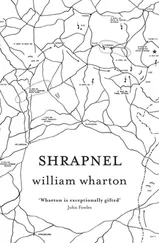Matt is making the same kind of clawlike upward motions with his hands Teurnier was making. It seems sort of precarious to me, but it’s too late now, and what else could we do anyway?
I’m at the highest part of the whole convoluted, bizarre complex, up on the roof of the covered hatch to the crew cabin of the lower boat, holding on to the high edge of the wooden boat’s roof. I look along the entire length before me and the view is somehow sexy, a lovely white lady lover of a wooden boat, hovering over, then lowering herself gently onto this rising giant of a black bull barge in the swirling water. Powerful, forceful jets of water surge from her supine lover, spewing up and splashing down into the river.
Just then, it starts to happen. I should have kept my dirty old man’s mind on the job, holding down that boat. I don’t, to this day, know what actually transpired. The hull is about halfway emptied, when suddenly there’s a sort of lurch, then slowly, both boats begin to tip toward the downriver side! My first thought is it’s from the pressure of river water against the hull. Or, maybe my normally optimistic Russian friend was right after all.
The boats, relentlessly, persistently, continuously tip. I move slowly. I’m still, ridiculously, trying to hold my original wooden boat from sliding off into the water, which it seems to be doing, despite the supposed effect of those jagged gripping hatches.
Everybody’s running around this way and that, cursing in Breton, French and general international obscenity. I don’t know what they’re doing, or why. M. Teurnier actually goes into the river with all his clothes on and is wrestling with something underwater. I hope he doesn’t lose his skin – I’m beginning to feel I’m losing my shirt.
He comes bounding out and runs past me up the tipping metal hull on the upriver up-boat side. I’m still frantically holding on to the edge of the roof, stupidly trying to convince myself I can keep the boat from tipping off and into the water sideways. But even more, I’m holding on for dear life. As he goes by, M. Teurnier mumbles just two words, two words even I can understand, ‘ C’est malheureux .’ In direct translation, ‘It’s unhappy.’ It seems a masterpiece of understatement.
They’re still pumping water out of the lower barge like madmen. I’m convinced the answer is to pump water back into the barge and start over again, or just leave the entire mess down there. I’m spinning, considering opening a restaurant, an underwater Philadelphia-hoagie restaurant specializing in ‘submarine’ sandwiches à la Seine. What else?
Gone with the Wind
We eventually tip over to a thirty-six-degree angle from the level of the water on the high side. I measure it, later, from the watermark on the cut end of the boat.
Realizing how foolish I must look trying to hold my big wooden boat in place at an angle, I let go an instant to search for the best place where I can jump when this leaning tower of a boat gives in to gravity. That upper boat actually starts to lift , to tip slowly, when I let go! I grab hold with both hands and press down desperately. The captain will go down with his ship, or is that ships.
Then, for reasons I still don’t understand, the tipping slows, then stops. Gently the barge rights itself. In no time at all, it’s level. My leaking old wooden boat squats properly on top, more or less dry, properly placed and aligned.
I drop to my haunches on the hatch cover because my knees are so weak I can’t stand. I hear the cheers of our gallery, but I’m crying and too completely pooped physically and mentally to take a bow. I’m in the stern. I’m invisible to them.
M. Teurnier comes around with a big wrench knocking along the bottom of the upper boat for some reason, maybe it’s like kicking tires on an automobile. When he sees me, he breaks into a huge smile and reaches over; we shake hands. Then he winds it up with one of those masculine French hugs that can break ribs. He’s soaking wet, so now I am, too, combination of river and sweat. We’re both laughing.
He passes me and continues around with his ‘tire thumping’. I manage to stand alone on my wobbling legs and work my way to the other end, the shore end, of the boat. There’s an apron about two feet wide on each side of the upper boat where the metal barge is wider. It makes a passable yet treacherous walkway. I hold on to anything I can find to inch myself along.
When I come to the bow of the boat, the end facing land, there’s another rousing cheer. I look up and wave a hand, feeling like Jacques Cousteau. Maybe the crowd thought I was actually holding the wooden boat in place up there with my bare hands. I’ll take any kudos I can get, deserved or not. Sternly, I decide not to bow in the bow. It wouldn’t be seemly.
Our next maneuver is to clear out a space for our new enlarged ‘bastard’ boat. Our old one, the wooden sinker, was only eighteen meters long. We now need to fit twenty-three meters of metal barge into the old space. There appears to be enough room between my barge and the neighboring houseboats, but that isn’t exactly the dilemma.
The first difficulty is physical. It seems there’s a sandbar there, which will keep my barge, much deeper in the water now than before, from squeezing into the old place. This sandbar has built up over the years. When it was only my light wooden boat, this didn’t matter, but with my new, heavy, metal monster, five times as bulky, it’s a serious affair. When we try easing the barge into place, it just won’t fit.
The second horn of the dilemma is political, psychological, psychic, etc., but we’ll come to that. I’m still shaky and covered with sweat, dirt and water. The pumps inside the metal hull are running hard, pulling out the last dregs. Two of M. Teurnier’s brothers are down there, more or less vacuuming up the last of the water.
M. Teurnier explains the problem to Matt. A good part of our audience has disappeared. The show is over. That’s what they think; the best (worst) is yet to come. Matt translates, explains about the sandbar. M. Teurnier wants to pull our barge out to the center of the river and bring their boat into the space. Then they’ll turn on the motors full blast and blow out the sandbar. He’s convinced it will work. I’m not, but what do I know, this is all in the area of hands-on nautical engineering.
So, that’s what we try to do. The barge is pulled out into the center of the river and anchored somehow. Where did they find the anchor? I don’t know. Then, they wedge their flat-topped boat into the space. This boat could serve as a landing field for small helicopters. They turn the double motors on full blast. Water, sand and sound fill the air.
Now comes the political, psychological, psychical part. Madame Le Clerc, our downriver neighbor, is standing perilously at the stern of her boat, shouting. But no one can hear with all the racket. She’s shaking her finger at M. Teurnier and at me. I pretend not to see. What can I do? M. Teurnier bends backward at the waist with his hands on his hips and laughs at her. Oh, boy!
Next, the owner of the boat on the other side, our upriver neighbor, with the lovely pirate boat, is out on her poop deck shouting even louder. If one didn’t see us between them, one would think they were having a terrible argument, shouting dementedly at each other. Too bad that isn’t the case. We are caught directly in the crossfire, and we are not innocent bystanders.
There ensues about fifteen minutes of roaring motors, rushing water, flying sand, a wild churning up of the river. It’s making a colossal stink because the propellers of the boat are releasing years of buried methane gas. It smells ten times worse than the sewers in Paris. Finally, they turn the motors off. M. Teurnier has a gaffing hook and is testing for depth. Unfortunately, now we can hear the ladies shouting. I’m glad I can’t understand. I’m as deaf to what they’re saying as I was with the motors roaring. Matt shakes his head and doesn’t want to translate.
Читать дальше












